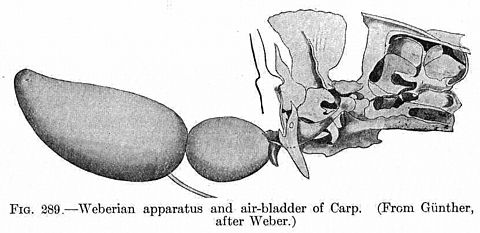Weberian apparatus

The Weberian apparatus is an anatomical structure that connects the
Structural anatomy and function
The generalized structure of the Weberian apparatus is akin to a skeletal complex of bones and ossicles that are physically connected to the
The Weberian apparatus functions by transmitting auditory signals straight from the
Embryology
Study of the embryology of the Weberian apparatus has since been conducted on various other ostariophysan species, the outcomes of which have resulted in various interpretations of the development (and thus the
Evolutionary history
The earliest recorded incidence of a Weberian apparatus is from the fossil fish
Etymology
The Weberian apparatus is named after the
See also
References
- ^ a b c Rosen, Donn Eric; P. Humphry Greenwood (1970-08-26). "Origin of the Weberian Apparatus and the Relationships of the Ostariophysan and Gonorynchiform Fishes". American Museum Novitates (2428). New York, New York, USA: American Museum of Natural History.
- ^ ISBN 3-89937-053-8.
- .
- S2CID 30275470.
- JSTOR 1447426.
- .
- ^ Rui, Diogo. "Origin, Evolution and Homologies of the Weberian Apparatus: A New Insight" (PDF). Int. J. Morphol. 2: 333–354.
- ^ Weber, Ernst Heinrich (1820). De aure et auditu hominis et animalium. I — De aure animalium aquatilium (in Latin). Leipzig, Germany: Gerhard Fleischer.
- JSTOR 1437878.
Bibliography
- Weber, Ernst Heinrich (1820). De aure et auditu hominis et animalium. I — De aure animalium aquatilium (in Latin). Leipzig, Germany: Gerhard Fleischer.
- Grande, Terry; Mario de Pinna (2004). G. Arratia & A. Tintori (ed.). The evolution of the Weberian apparatus: A phylogenetic perspective (PDF). Mesozoic Fishes 3 – Systematics, Paleoenvironments and Biodiversity. München, Germany: Verlag. pp. 429–448. ISBN 3-89937-053-8.
- Manley, Geoffrey A.; Arthur N. Popper; Richard R. Fay (2004). "Chapter 5: Evolution of Single- and Multiple- Ossicle Ears in Fishes and Tetrapods". Evolution of the Vertebrate Auditory System. Chapter by Jennifer A. Clack and Edgar Allin. Springer. p. 415. ISBN 978-0387210933.
- Bird, Nathan C.; L. Patricia Hernandez (2007-06-25). "Morphological variation in the Weberian apparatus of Cypriniformes". Journal of Morphology. 268 (9). Wiley-Liss, Inc., A Wiley Company: 735–757. S2CID 29393291. Archived from the originalon 2013-01-05.
